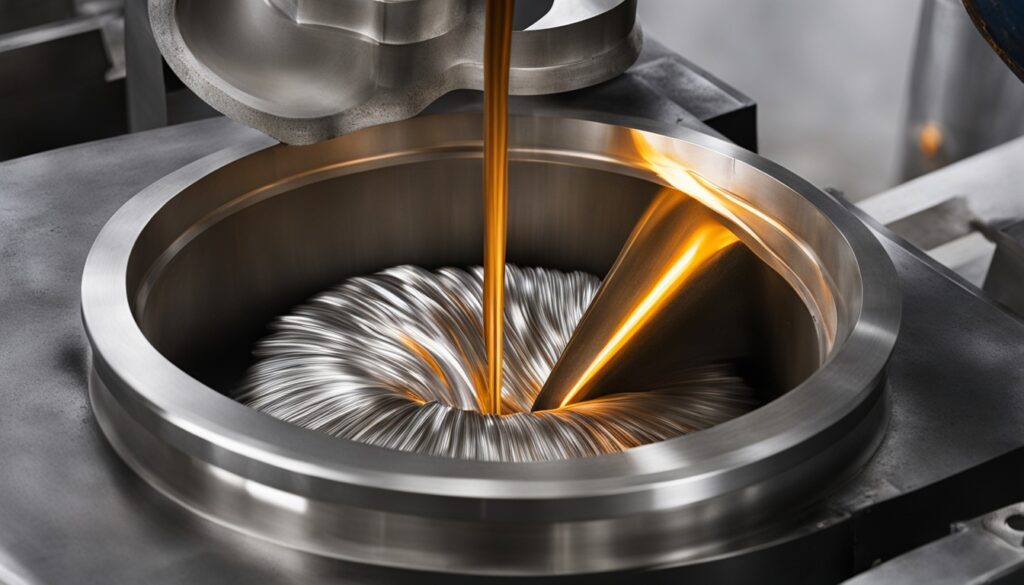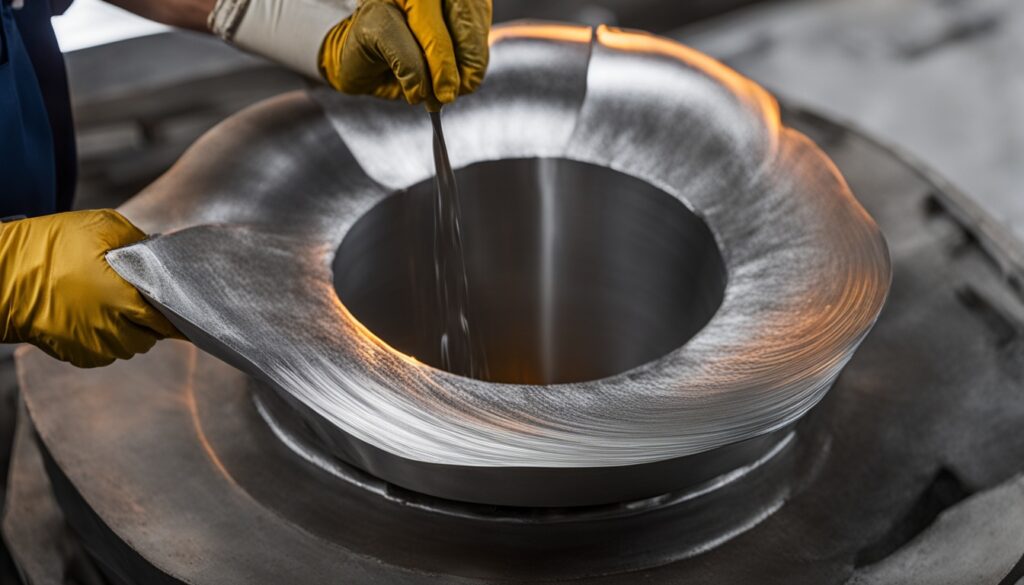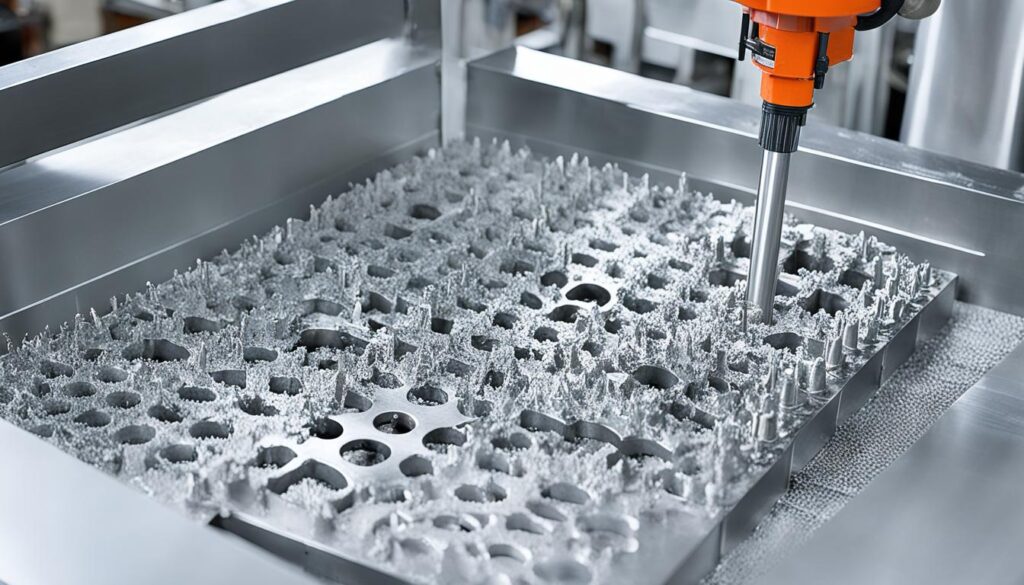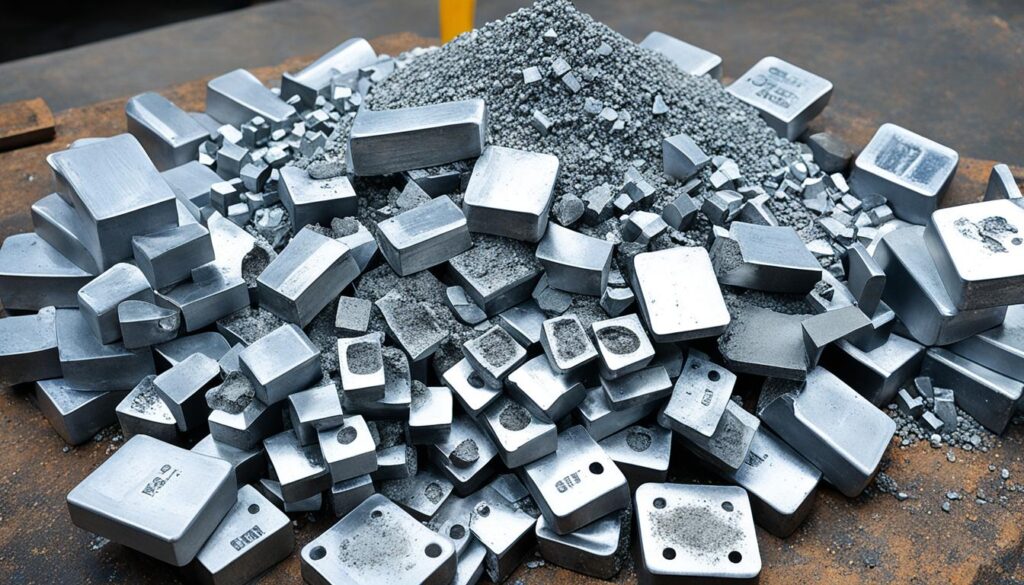Gravity casting, also known as permanent mold casting, is key in making things and shaping metals. It uses gravity to fill a mold with hot metal, making parts that are precise and look great. This method, a type of die casting, has grown from old metalworking to today’s advanced uses. Aluminum gravity casting beats other methods in quality, precision, cost, and speed.
Key Takeaways
- Gravity casting, or permanent mold casting, is a highly effective metal forming process.
- It uses the force of gravity to fill a mold with molten metal, enabling the creation of precise and complex parts.
- Aluminum gravity casting provides superior quality, precision, and cost-effectiveness compared to other casting methods.
- The process has evolved from ancient metalworking practices to modern, sophisticated applications.
- Gravity casting is a versatile technique with a wide range of industrial applications.
What Is Gravity Die Casting?
Gravity die casting is a way to make parts by pouring molten metal into a mold. This method is better than traditional sand casting. The metal flows into the mold because of gravity. You can control how full the mold gets by tilting the die.
You can also add special shapes inside the part using sand cores. This process makes parts with a smooth surface and strong mechanical properties. This is because the metal solidifies quickly.
Gravity Die Casting Explained
In gravity die casting, molten metal goes into a mold made of steel or cast iron. The metal moves into the mold on its own, thanks to gravity. This method gives parts a smooth surface and makes them stronger than those made by sand casting.
Advantages of Gravity Die Casting
- Possibility of low gas porosity
- Fine grain sizes
- Less finishing and fettling required compared to sand casting
- Tends to produce a higher-quality product
- Higher casting rate than aluminum sand casting
Gravity die casting uses metal molds, which cost more than sand molds. But, it has many benefits. It’s a popular choice for many uses. The quick solidification and ability to add special shapes make it efficient and versatile.

Gravity die casting is a method that uses gravity to fill molds with molten metal. It makes parts with a smooth surface and strong properties. This makes it a valuable tool in metal forming.
Aluminum Gravity Casting: A Versatile Process
Aluminum and its alloys are top picks for gravity die casting. They have a low melting point, flow well when melted, and have great mechanical properties. This makes aluminum perfect for many uses, like in cars, planes, and industrial parts.
Gravity die casting is a flexible process. It lets makers create complex aluminum parts with high precision and speed. It’s great for making parts with complex shapes, thin walls, and tight tolerances. This is why it’s so popular in many fields.
One big plus of aluminum gravity casting is the smooth surface finish it produces. This often means less work after the casting is done. The process also lets makers add details like holes, ribs, and complex shapes without weakening the part.
This method also ensures parts have accurate dimensions and are very consistent. This is key in industries like the automotive and aerospace, where precision and reliability matter a lot.

Aluminum’s unique properties and the gravity die casting process make it a top choice for many uses. From car parts to plane structures, aluminum gravity casting is key in making quality, affordable solutions for today’s industries.
Step-by-Step Gravity Casting Process
The gravity casting process has key steps for making high-quality aluminum parts. Let’s explore each stage of this efficient method.
Preheating and Coating the Mold
First, the die (mold) is warmed up to avoid cold spots and ensure the metal solidifies evenly. This prevents damage to the die and helps it last longer. Also, a special coating is put on the mold’s inside to make removing the solid part easy after casting.
Pouring Molten Metal into the Mold
With the die ready, molten metal is poured into it. This metal is usually aluminum or other non-iron alloys. It flows into the mold under gravity, reducing mess and air pockets.
Solidification and Cooling
The metal cools down fast in the mold. It starts to solidify first where it touches the mold’s cooler parts. This process moves towards the casting’s center. Warm molds help solidify the metal evenly, stopping it from freezing too soon in thin areas.
Ejecting the Finished Part
Once the metal is fully set, the die is opened to show the casting. The special coating helps remove the casting easily. Sometimes, more work like machining is needed to finish the product’s shape and look.

Materials Suitable for Aluminum Gravity Casting
Aluminum and its alloys are top picks for gravity die casting. They have a low melting point, flow well when melted, and have great mechanical properties. This makes aluminum perfect for many uses.
Other materials that work well for gravity die casting are:
- Steel
- Magnesium
- Cast iron
- Copper alloys
These materials are not as common as aluminum but have their own benefits. They suit certain needs and performance goals.
| Material | Melting Point | Fluidity | Mechanical Properties |
|---|---|---|---|
| Aluminum | 660°C (1,220°F) | Excellent | Good strength, lightweight, and corrosion-resistant |
| Steel | 1,538°C (2,800°F) | Good | High strength, durability, and wear resistance |
| Magnesium | 650°C (1,202°F) | Excellent | Lightweight, good strength-to-weight ratio |
| Cast Iron | 1,200°C (2,192°F) | Good | High compressive strength, good wear resistance |
| Copper Alloys | 1,083°C (1,981°F) | Good | High thermal and electrical conductivity |
The choice of material for gravity die casting depends on the project’s needs. This includes the mechanical properties wanted, weight limits, and cost factors.

Industries Utilizing Aluminum Gravity Casting
Gravity-cast aluminum parts are used in many industries. They are very useful because of their strength and light weight. The automotive and aerospace industries use them a lot.
Automotive Applications
In cars, gravity-cast aluminum is great for its light weight and strength. You can find it in many parts, like:
- Engine blocks
- Transmission housings
- Suspension components
- Body panels
These parts are made with great precision. This makes them perfect for important car parts. They need to work well and last a long time.
Aerospace Components
The aerospace industry also uses gravity-cast aluminum a lot. These parts are made with amazing precision. They are great for making complex parts for:
- Aircraft
- Satellites
- Other aerospace systems
These parts are strong, light, and very accurate. They meet the tough standards of the aerospace world. This is important for their high-stress jobs.
“Gravity-cast aluminum components are essential in the automotive and aerospace industries, providing the perfect balance of lightweight construction and superior strength.”
| Industry | Key Applications | Benefits of Gravity Casting |
|---|---|---|
| Automotive |
|
Lightweight, high strength-to-weight ratio |
| Aerospace |
|
Precision, high performance, and dimensional accuracy |
Aluminum Gravity Casting at KT-Foundry
At KT-Foundry, we make high-quality aluminum gravity die castings for many industries. Our skills and modern facilities let us make complex parts that match our customers’ exact needs. We work with our clients to give them solutions that are both high in quality and cost-effective.
We focus on making every step of our aluminum gravity casting process perfect. We use the newest technologies and best practices to make parts that our clients love. Our team is skilled in making parts for cars and even aerospace, aiming for the highest standards.
Understanding the aluminum gravity casting process is key for us. We watch every step, from preparing the mold to ejecting the final part, to make sure it’s up to our high standards. Our focus on details and always improving has made us a trusted name in the industry.
Clients pick KT-Foundry for our dedication to innovation and excellence. We’re always finding new ways to improve our processes and give more value to our customers. Whether it’s making new mold designs or using the latest automation, we aim to lead in aluminum gravity casting.
“KT-Foundry has been a key partner in our search for quality and cost-effective aluminum castings. Their knowledge and focus on details have helped make our projects successful.”
– John Doe, Director of Manufacturing, ABC Corporation
KT-Foundry is a top choice for aluminum gravity die castings, offering great products and unmatched customer service. We invite you to see the KT-Foundry difference and how our innovative solutions can change your manufacturing.
Innovations in Gravity Die Casting
In the world of metal casting, innovation has led to big changes in gravity die casting. Two main areas have changed this process a lot. These are advanced mold design and using automation and robotics.
Advanced Mold Design and Materials
3D printing technology has changed how molds are made for gravity casting. Now, complex shapes can be made easily that were too hard or too expensive before. This means making molds faster and opening up new possibilities in gravity casting.
Also, using specialized steel alloys for molds has made them last longer and work better. These materials make the mold more durable and help make the final castings better and more consistent.
Automation in Gravity Casting
Automation and robotics have changed gravity casting a lot, making it more precise and efficient. Automated pouring systems make sure the metal goes into the mold the right way. Also, simulation software and tools help make gravity casting more reliable and big in scale.
These changes in mold design and automation have changed the gravity casting industry a lot. Now, manufacturers can make high-quality castings faster and at a lower cost.
Precision and Quality with Gravity Die Casting
Gravity casting is great at making parts with top-notch surface finishes and exact dimensions. This is key for complex shapes and designs. The metal flows smoothly into the mold, reducing air pockets and making parts defect-free and smooth.
Gravity die casting uses gravity to fill the mold, ensuring metal flows evenly. This method is precise, hard to match with other casting ways. The parts come out with great detail and stability, perfect for demanding applications.
| Characteristic | Gravity Die Casting | Other Casting Methods |
|---|---|---|
| Surface Finish | Exceptionally smooth and uniform | Varying levels of surface quality |
| Dimensional Accuracy | Tight tolerances, minimal variation | Greater variation in part dimensions |
| Internal Defects | Minimal air pockets or inclusions | Increased risk of internal defects |
Gravity die casting’s steady metal flow and controlled cooling lead to high-quality parts. It’s the top pick for industries needing precision, like the automotive, aerospace, and medical fields.
“Gravity casting’s ability to produce parts with exceptional surface finishes and dimensional accuracy is a game-changer for industries that demand precision and quality.”
Using gravity, gravity die casting offers unmatched control and consistency. This results in parts that meet strict quality standards. Its precision and cost-effectiveness make it a smart choice for manufacturers aiming to improve their production and satisfy customer needs.
Cost-Effectiveness of Aluminum Gravity Casting
Gravity casting is a cost-efficient way to shape metals. It works well for making both small and large batches. This method cuts down on waste and makes production smoother, balancing quality and cost.
Using metal molds in gravity casting is a big plus. These molds can be reused many times. This means the cost of making each part goes down over time.
Gravity casting also saves materials by producing less scrap. This is especially good for projects that use expensive metals or need a lot of parts. Saving on materials means saving money.
| Feature | Benefit |
|---|---|
| Reusable Metal Molds | Amortized mold investment over multiple casting cycles, reducing per-unit cost |
| Material Conservation | Reduced scrap and waste, leading to cost savings, especially for high-volume or expensive alloy projects |
| Streamlined Production | Efficient manufacturing process with minimal material waste, optimizing quality and cost |
Aluminum gravity casting is a smart choice for many industries. This includes the automotive and aerospace sectors, where quality and cost matter a lot. By using this process, companies can save money and make high-quality parts.
Comparison to Other Casting Methods
Looking into aluminum casting, it’s key to see how different methods compare. We’ll look at sand casting and die casting. Each has its own benefits and things to think about.
Sand Casting vs. Gravity Die Casting
Sand casting and gravity die casting are different in how they make the mold and fill it with metal. Sand casting uses sand molds that are thrown away after use. Gravity die casting uses metal molds that can be used many times.
This choice of mold material gives gravity die casting some big advantages:
- Superior surface finish and mechanical properties of the cast parts
- Higher production rates due to the reusable nature of the metal molds
- Tighter dimensional tolerances and better repeatability compared to sand casting
Die Casting vs. Gravity Casting
Gravity casting and die casting are also worth comparing. The main difference is how the molten metal gets into the mold. Gravity casting uses gravity to fill the mold. Die casting injects the metal under high pressure.
| Feature | Gravity Casting | Die Casting |
|---|---|---|
| Mold Filling | Gravity | High Pressure Injection |
| Production Rate | Medium to Large | High-Volume |
| Cost-Effectiveness | More Cost-Effective | Higher Initial Investment |
Gravity casting is often cheaper for making lots of parts. Die casting is better for making a huge number of parts because it can make more at once. But, die casting costs more to start because of the special machines needed.
Knowing the differences between these casting methods helps pick the best one for a project. You need to think about how complex the part is, how many you need, and what you can afford.
Conclusion
The future of gravity casting is bright, with ongoing innovation and a growing role in making things. As new techniques come along, gravity casting will keep being a key part of making metals. At KT-Foundry, we aim to lead in aluminum gravity casting, offering top-notch quality and value to our clients.
KT-Foundry is leading the way in aluminum gravity casting. We focus on pushing the limits of this process. By using the latest in mold design, materials, and automation, we make products that are precise and reliable. This meets the needs of many industries.
We’re excited for the future of gravity casting. We’re committed to being sustainable, efficient, and understanding what our clients need. KT-Foundry is ready to shape the future of metal casting. Aluminum gravity casting is key in modern manufacturing for its versatility, cost-effectiveness, and quality. We’re honored to be part of this journey.
FAQ
What is gravity die casting?
Gravity die casting is a way to make parts by pouring molten metal into a mold. The metal flows into the mold because of gravity. This method can create parts with undercuts and cavities using sand cores.
It gives parts a smooth surface and strong mechanical properties because it solidifies quickly.
What are the advantages of gravity die casting?
This method has many benefits. It can produce parts with little gas porosity and fine grain sizes. These parts also need less finishing work than those made by sand casting.
Moreover, it makes high-quality products. It casts parts faster than aluminum sand casting, but metal molds are pricier.
What materials are suitable for aluminum gravity casting?
Aluminum and its alloys work best for gravity die casting. They melt easily, flow well, and have good mechanical properties. This makes aluminum perfect for many uses.
Other materials like steel, magnesium, cast iron, and copper alloys can also be used. But they’re not as common as aluminum.
What are some of the industries that utilize aluminum gravity casting?
The automotive and aerospace industries use gravity-cast aluminum a lot. They value its light weight and strength. You’ll find these parts in engine blocks, transmission housings, and more.
In aerospace, gravity-cast aluminum is crucial for making parts for aircraft and satellites. Its precision and quality are unmatched for these high-performance needs.
How does gravity die casting compare to other casting methods?
Gravity casting uses a metal mold filled with molten metal under gravity. This is different from sand casting, which uses sand molds. Gravity casting has a smoother surface and better mechanical properties than sand casting.
It also produces parts faster. The main difference with die casting is how the molten metal gets into the mold. Gravity casting uses gravity, while die casting injects it under pressure.
Gravity casting is more cost-effective for making medium to large quantities. Die casting is better for high-volume production.


